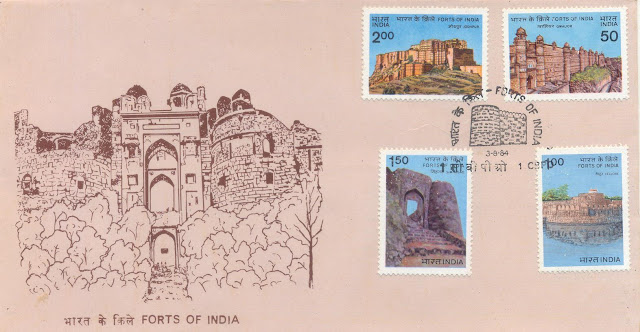The 50, 100, 150 and 200 P. stamp depict the Forts of Gwalior, Velore, Simhagad and Jodhpur respectively.
THE FORTS OF INDIA Built by titans and lit by the glory of fire, blood and love- the grandest sights in India. The Forts of India, stand as befitting 'monuments' to the pride, courage and chivalry of the rulers and people of India who relentlessly strove against invading armies to preserve their freedom and to keep alive their fait and their culture.
The Gwalior Fort was built by a Rajput chieftain named Suraj Sen in gratitude to Gwalipa, an ascetic who cured him of Leprosy. Like other Forts, the Gwalior Fort is situated atop a hill, some 300 feet above the plains. The hill is 1,3/4 mile long and the breadth varies from 600 to 2200 feet. The enclosing wall is 30 feet high. The main attractions within the gates are gigantic Jain sculptures carved along the rock face of the Fort, Man Mandir, Gujri Mahal, Sas Bahu Temple and Teli-ka-Mandir. Each of these monuments bear a distinct stamp of individuality and all are noted for the simplicity of style and rugged beauty of strength.
The Fortress of Vellore is situated about 125 kms. west of Madras. Built in this historical town, the Fort is one of the most perfect specimen of military architecture in the South. The 'Ethaladurg' or Land Fort was built by Chinna Nayak a subordinate Chief under Sada Sivaraya and Sri Ranga Maharaj, the Vijaynagar Kings in the third quarter of the 16th century AD.
SIMHAGAD Formerly known as Kondhana, the earliest mention of this Fort is to be found in Isamis Futuh-us-Salatin, when the Fort was taken over by Mohammad-bin-Tughluq from the Kolis. The Fort was again captured by Malik Ahmed Nizam, the founder of Nizamshahi dynasty of Ahmadnagar in 1483 AD. The Fort was given in Jagir to Shivaji's father Sahaji Bhosle by the Nizamshah of Ahmadnagar. The Fort had to be handed over to the Bijapur Sultan, from whom Shivaji captured the Fort by force, and it remained in his possession for a long time with the exception of a short period. In the beginning of 1670 AD Shivaji's Infantry General Tanaji Malusare captured the Fort from the Mughals, but lost his life in the action. From this incident springs the story that Shivaji renamed the Fort as Simhagad after Tanaji. From Shivaji the Fort further changed hands, to Aurangzeb, to Marathas, to Mughals, to the Peshwas and finally to the British. Shaped like an axe with a short handle, the Fort occupies on area of about two-square miles. The top is very rugged and surrounded by strong fortification on all sides, and is flanked by 33 towers or bastions. Only those parts of the hill which are naturally protected by steep precipices are left without walls and it is the western part of these natural fortifications that Tanaji Malusare is said to have scaled in his invasion of the Fort, The Fort is situated about 15 miles to the south west of Pune, 4322 feet above sea level and 2300 feet about Pune plains.
The historic fort of Jodhpur was founded by Rao Jodha in the year 1459 AD: who shifted his capitol from Mandore to present day Jaodhpur. Its original names were 'Chintamani' and 'Mordhaj' but later on it came to be called as Meherangarh- The Majestic Fort. The Fort stands out magnificently on an isolated rock about 400 feet above the city. It is the finest example of beautiful architecture, which can rightly be described as 'Poetry in Stone'.

No comments:
Post a Comment